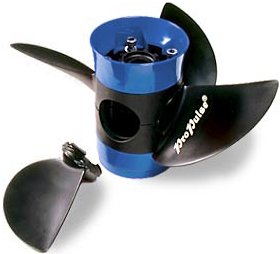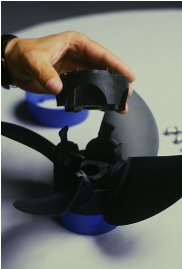|
|
The Swedish adjustable propeller
 Published
in "Venepörssi no. 2 /2002" Published
in "Venepörssi no. 2 /2002"
Trolling with the ProPulse
propeller
When you travel in Finland you meet
two types of people in fishing situations, and both think they are the country’s
best, namely those who make and heat smoke saunas and those who salt fish. Among
pleasure boat owners, and especially within trolling, there are just as many
experts on trolling speeds and propeller choice.
We will now make our contribution to this, something that is bound to arouse
views and arguments from different quarters. But that doesn’t matter! The
Swedish ProPulse propeller is made from composite and is equipped with
adjustable pitch. The propeller serves trollers in a number of ways. It has many
good properties.
Anyone who has seen the chassis of a Formula 1 car on TV has probably wondered
why the so-called base plate is not made of steel, after all it is black. In the
same way, you wonder about rally cars bouncing over the brow of a hill in the
woods. Their armour base, which is traditionally made from steel or aluminium,
is black and looks like plastic even though it is impossible to break. And what
about the Hornet fighter, or mobile telephones or just about anything – in many
designs today, steel, metal and aluminium are replaced with either carbon fibre
or, as in the case of ProPulse, composite. The material is strong, light and
easy to shape.
Choose the size
The ProPulse propeller is
manufactured in Sweden for outboard engines, and I first came across it two
years ago at the boat fair in Helsinki.
The importer’s representative and a Swedish friend from the factory naturally
thought I should test the propeller, which is perfectly suited to trolling.
"The propeller has five different pitch settings. It is light and strong. Even
if you should hit a stone, you can place two of the remaining blades, or the
replaceable spare blades you carry, against each other, continue trolling and
then chug home in the evening. There is no need to stop fishing because the
propeller is damaged," the men assured.
In strong headwind I had to increase the engine speed to 1000 rpm to maintain my
favourite speed. The propeller has shown its good qualities, especially when it
comes to speed for the demanding drag fishing. With or without paravanes – at
least in my boat you can use the engine speed to maintain steering ability even
when the weather is bad, and you do not have to spend all your time manoeuvring
frenetically, which is very trying when you are running the engine close to idle
speed during trolling.
Let’s test it!
One day in November, we carried out
our own little test in Saimens Kyläniemi.
For our test we used a Silver Eagle
Cabin equipped with a Honda BF 130. As load, there were three full-grown men,
petrol and miscellaneous equipment weighing approx 100 kg. With the north wind,
the weather was naturally bitterly cold and the wind raised a few waves; you
could say it was your typical autumn weather.
We decided not to use planer board. For our test runs we did not lower any other
fishing tackle into the water either, instead we ran the tests with the given
load and only the above-mentioned boat/engine combination. That is because no
two fishing boats have exactly the same fishing tackle.
A very common boat/engine combination forms the basis of our test, and the
reader can easily add the drag for his own fishing tackle in order to estimate
his own speed.
We started our test with four propeller blades installed and 17-inch pitch, i.e.
the smallest possible pitch for the biggest of the ProPulse models, for which
the greatest pitch is 21.
At 1000 rpm, the speed of our boat with a crosswind was 3.02 knots (5.6 km/h),
and when we turned the boat into the wind, the gps showed a drop in speed of
half a knot. The corresponding figure at 2000 rpm was 5.94 knots (11 km/h), and
at 3000 rpm 8.8 knots (16.3 km/h). At full power the engine speed was 5900 rpm.
At the maximum engine speed of 6000 rpm, the boat speed was 30.3 knots (56
km/h). Wow!
The propeller coped easily with the trimming and the pointer of the trim gauge
up to the horizontal line, which it just sailed past! It did not take long for
the gauge to reach the max position and not a sign of slipping. We had to finish
the tests, as there was no slipping, even though the trimming reached its
maximum and the machine had already risen one centimetre towards the planing
phase!
At this stage, real boat enthusiasts start to cough and raise a warning finger.
The trimming ability was good due to the propeller, but if you drive like this
then the economy, the noise and a lot of other things will not be at an optimum.
The engine on our test boat ought to be lifted one or two centimetres at the
stern. This way, by adjusting the position of the engine you not only achieve
good driving efficiency, but also the best fuel consumption, the least noise and
good steering. The rule of thumb allows the propeller to race at the trim
gauge’s horizontal line. This is no disgrace for the propeller, engine or boat,
however, as long as the engine is mounted at the right height. Despite this, the
enormous efficiency of ProPulse made a big impression.
Remove half
 We then simulated a
situation in which we had run aground, removed the damaged blades and were
intending to fish by running on two propeller blades for the rest of the day
before driving home. How does the propeller maintain the trolling speed? What is
the cruising speed like? What happens to the cruising speed with half the
blades? Will it work at all, or was it all just sales talk? We then simulated a
situation in which we had run aground, removed the damaged blades and were
intending to fish by running on two propeller blades for the rest of the day
before driving home. How does the propeller maintain the trolling speed? What is
the cruising speed like? What happens to the cruising speed with half the
blades? Will it work at all, or was it all just sales talk?
We removed two blades, adjusted the remaining blades to maximum, i.e. 21-inch
pitch, using the scale on the propeller collar. When adjusting the angle you
loosen four hexagonal bolts and then turn the two opposite blades. The marking
on the propeller housing is moved in the required direction on the +/- range by
changing the direction of the turn.
The Swedes could develop the adjustment mechanism further, as an inexperienced
person who is lacking in technique will use too much force, particularly in the
beginning. There is a risk that the propeller comes apart in your hands. The
propeller can be tightened with the hexagonal bolts, but the propeller collar
must only be pushed down under the narrow edge of the hexagonal heads; it may
look a bit weak, but it has been enough to keep it in place. The adjustment of
the propeller becomes easier if you spend a bit of time practising.
The propeller pulled surprisingly well with only two blades. At trolling speeds,
i.e. engine speeds of 600-700 rpm, the propeller could maintain a speed of
2.7-3.3 knots without problem, i.e. you can start trolling with paravanes even
if you do not have a full complement of propeller blades.
Anyway, 3000 rpm and 7.8 knots (14.6 km/h) were values that ProPulse did not
exceed with half the number of propeller blades. At the above speed you will get
home, however, and while you are chugging along you have time for a drink from
your flask.
A question mark remains over whether the efficiency would have been better at a
higher engine speed had you been able to put something in the round holes left
by the removed blades.
Somehow you had the feeling that the holes were not exactly an advantage…
In any case, ProPulse gave a good
impression.
 As has been said,
adjustment becomes easier with a little practise even if it does not seem so at
first. As has been said,
adjustment becomes easier with a little practise even if it does not seem so at
first.
ProPulse has also proved to be very strong! A member of our fishing company
swung a ball from the rig with the swinging arm so the ball hit the propeller
with a direct blow! We thought then, with the votes at 3-0, that the Swedish
invention would disappear down to the bottom of the sea, but no! To the best of
our abilities we could not find any visible marks on the blades. But the ball,
which was made of lead, was full of cuts, as if someone had repeatedly taken a
small axe to it ...!
There are 9 propeller alternatives, for engines up to 300 HP. The packaging
contains a list of suitable engines, and it is extensive.
Prices range from $265 to $414 AUD and spare blades from $54 to $71 AUD. Even if
the price is in line with prices of traditional "rosettes", ProPulse has the
advantage of low blade repair costs and work can be carried out very quickly.
That is what gives ProPulse such a big advantage."
Wm. Olds & Sons Pty. Ltd. trading as OLDS ENGINEERING
ABN 33 009 859 250 - MECHANICAL ENGINEERING & FOUNDRY
78-80 North Street, Maryborough Q, 4650 Australia
P.O. Box 3030, Pallas St. Post Office, Maryborough Q, 4650
Phone: 07 4121 3649 Fax: 07 4123 3590 International Phone +61 7 4121 3649 Fax: +61 7 4123 3590
Innovative Engineering Excellence ~ serving over 100 years
|

 Published
in "Venepörssi no. 2 /2002"
Published
in "Venepörssi no. 2 /2002" We then simulated a
situation in which we had run aground, removed the damaged blades and were
intending to fish by running on two propeller blades for the rest of the day
before driving home. How does the propeller maintain the trolling speed? What is
the cruising speed like? What happens to the cruising speed with half the
blades? Will it work at all, or was it all just sales talk?
We then simulated a
situation in which we had run aground, removed the damaged blades and were
intending to fish by running on two propeller blades for the rest of the day
before driving home. How does the propeller maintain the trolling speed? What is
the cruising speed like? What happens to the cruising speed with half the
blades? Will it work at all, or was it all just sales talk? As has been said,
adjustment becomes easier with a little practise even if it does not seem so at
first.
As has been said,
adjustment becomes easier with a little practise even if it does not seem so at
first.